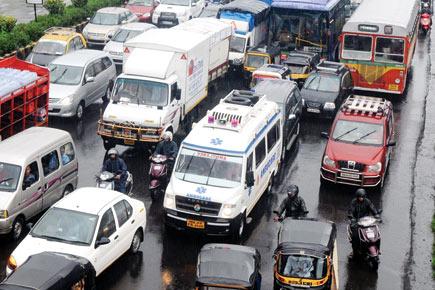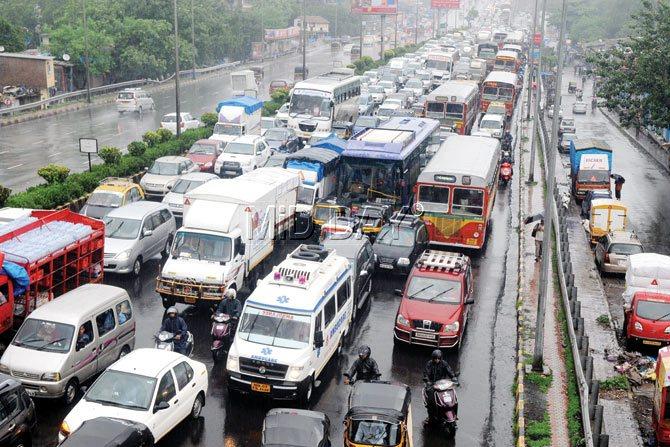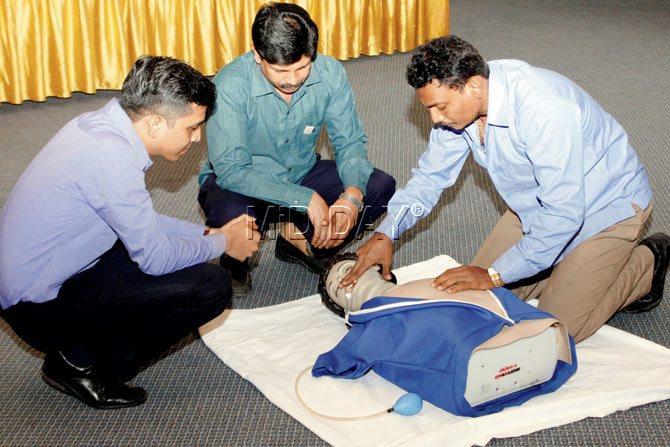Vile Parle's Nanavati Hospital has launched a 'Mujhe Raasta Do' campaign to create awareness about the need to make way for ambulances racing to reach patients in time

Ambulance
Frustrating at best and fatal at worst. That sums up the state of ambulances or trauma vehicles in Mumbai, often caught in a traffic snarl. To fix the problem, Vile Parle’s Nanavati Hospital has launched a ‘Mujhe Raasta Do’ campaign to create awareness about the need to make way for ambulances racing to reach patients in time.

NO WAY: An ambulance caught in a traffic jam at the Western Express Highway recently. PIC/ NIMESH DAVE
ADVERTISEMENT
Dr Sunil Bhaud, owner, Star Ambulance service, says, “Negotiating through traffic is a harrowing task for ambulance drivers. But we are seeing there are times when more people make way hearing the siren or the traffic police stepping in to clear the way. But a lot more needs to be done.”
It is not just getting the patient to the hospital that’s a priority, but reaching the ailing in the first place, that’s also a task. Dr Kumar Mulchandani, proprietor of another private ambulance service, Nulife Cardiac Ambulance, says, “Getting to the patient on time is as important as taking the patient to the hospital. We factor in 10 minutes, but due to traffic jams, it takes way longer to reach. The traffic police often haul up drivers of empty ambulances for using the siren. But the ambulance is bound to be empty when on its way to pick up a patient.”

BREATH CHECK: A paramedical instructor guides ambulance drivers on administering emergency procedures at Nanavati Hospital. PIC/TUSHAR SATAM
Raman Shroff, has been an ambulance driver for 10 years. He recollects being stuck in bumper-to-bumper traffic on the Eastern Express Highway once. “We were unable to get the patient to Hinduja Hospital in time. The relatives were screaming, but there was no way out of the traffic. It was a horrid drive. When we finally managed to reach the hospital, the patient had passed away. The family was blaming me; it was hard to get through that day.”
Doctors' speak
Dr Rajendra Patankar, Chief Operating Officer (COO), Nanavati Super Specialty Hospital says he and his colleagues realise that they may have the best hospitals, but if patients cannot reach them on time, they are of little use. “This lead us to start the ‘Mujhe Raasta Do’ campaign to create awareness about making way for ambulances in the city.”
The hospital organised a mock drill in August where ambulances from various parts of the city tried to reach the hospital in a stipulated time. Dr PM Doshi, Director of Traumatology, Orthopedics at Nanavati Hospital, says, “The ambulances reached in record time from Bandra, Malad, Juhu and Kalina areas. We also conducted lectures to sensitise rickshaw and taxi drivers to the need to make way for ambulances. There are times when cars and bikes follow an ambulance, taking advantage of the empty corridor. We are planning to educate communities too, to be aware of the need for a patient to get to a hospital quickly.”
Dr Prakash Jaindani, critical care expert at Wockhardt Hospital, raises the concern of the need for trauma vehicles to be well equipped. Dr PM Bhujang, President, Association of Hospitals (AOH), says, “The first few minutes upto an hour are crucial for patients. Many complications, even death, can be prevented if patients are brought on time and treated. Levying a fine on those who do not let the ambulance pass may be an option for the traffic police.”
Dr Doshi says it is often that a patient has lost a limb if not treated in the 60-minute golden hour.
Attitude change
Ambulance driver Kishore Lal, who is also a trained paramedic, says, “There are times when the police make way and let the ambulance go through. Sometimes, getting out of the traffic doesn’t take more than a few minutes. But, instead of police, I would be happy to see drivers get proactive.”
Yash Savla, veterinary student who uses his motorbike to commute, says, “I have seen people make way for an ambulance on the traffic-jammed Ghodbunder Road which I often take. I have even, on one occasion, got off my bike and ushered the ambulance through.”
“There have been times when I have felt helpless in a traffic jam. Hearing the ambulance siren wailing makes me want to do something. But with vehicles on my left and right there is little I can do,” says Paro Sen, an entrepreneur who uses her car from Goregoan to her office at the Bandra-Kurla Complex.
Mohammad Santrawala, an architect who drives from his Ghatkopar home to his Worli office, says, “When my wife was being rushed to hospital during labour, the ambulance was stuck in traffic. I experienced the traumatic wait one has when caught in traffic. Now, I try my best to make way for ambulances. There have been times when I have called the traffic police control room and asked for assistance.”
“People need to think that the person in the ambulance is a family member. That’s the mindset we need to inculcate. There is always space to be made, but people do not want to do it,” says Dr Jaindani.
Juhu resident Karan Yadav says, “There are a number of people who get into arguments when I try to make space for the ambulance to go. Sometimes, fights get nasty. The city also has a selfish face. A scratch on a car is nothing really; saving a life is important.”
Dr Patankar feels awareness should start at the school and college levels.
It is evident that there is need for a strong social conscience amongst us. Bridging the trust divide between authorities and ambulance drivers is vital. One always has to give the benefit of doubt to the ambulance personnel, who are racing to save lives. Overall sentiment though shows that despite everything, Mumbai has a compassionate heart. Let it beat to save a life.
Helping hand
>> If an ambulance is caught in a traffic jam, the traffic control numbers to call are 8879221100 (Mumbai) and 7738393839 (Navi Mumbai).
>> An ambulance is an emergency vehicle and it is legal to break a signal and give way if an ambulance is behind you.
>> As per the Rules of the Road Regulations 1989, every driver must give way to an emergency vehicle — ambulance or fire brigade — moving to the side of the road.
 Subscribe today by clicking the link and stay updated with the latest news!" Click here!
Subscribe today by clicking the link and stay updated with the latest news!" Click here!







